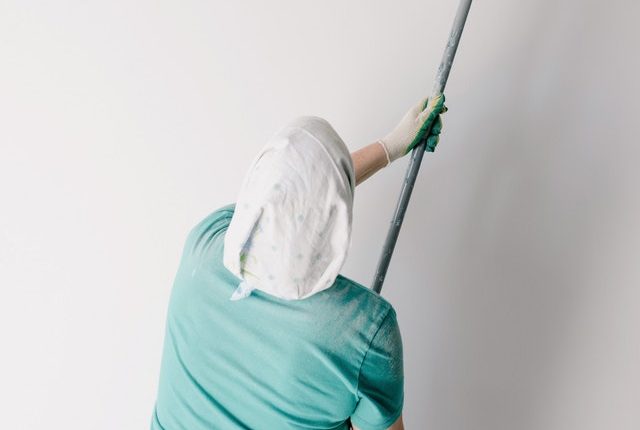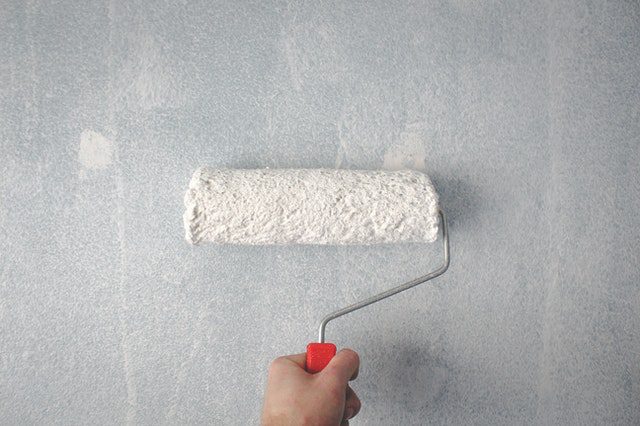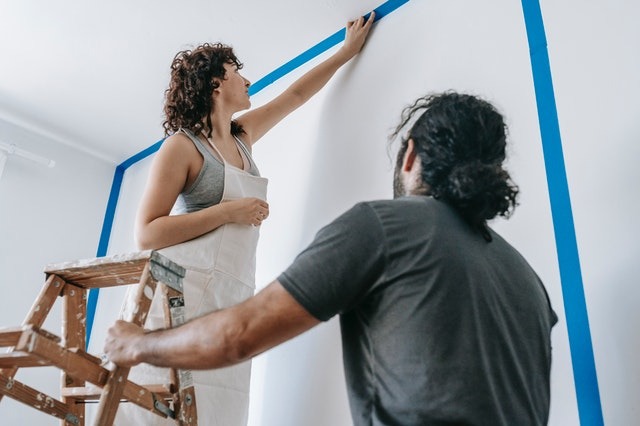
Your ceilings can be an easy way to update your home’s look, but painting them is a job that even the most experienced DIY enthusiasts dread. Depending on the room and the ceiling height, it can be difficult to get paint up there without leaving unsightly drips, runs and splatters.
However, with a bit of patience and practice, you can produce professional-looking results using these step-by-step instructions. Before we delve into the best way to paint a ceiling, lets go over the essential supplies you need to own.
 Is your ceiling smooth or textured? If the former, a low-nap roller will work best as it’s designed to pick up paint with minimal drips or sags. For textured ceilings, try using a 3/4 inch nap roller instead.
When buying rollers, try to look for the shortest roller extension pole possible. This will make painting your ceiling much easier as you’ll be carrying less weight when painting and be able to paint faster. Longer pole extensions, in contrast, will make the job more difficult, causing you to work harder than necessary.
Is your ceiling smooth or textured? If the former, a low-nap roller will work best as it’s designed to pick up paint with minimal drips or sags. For textured ceilings, try using a 3/4 inch nap roller instead.
When buying rollers, try to look for the shortest roller extension pole possible. This will make painting your ceiling much easier as you’ll be carrying less weight when painting and be able to paint faster. Longer pole extensions, in contrast, will make the job more difficult, causing you to work harder than necessary.
 Although painting a ceiling may appear straightforward, several important details can make or break your project. Here we answer some of the most frequently asked painting questions:
Although painting a ceiling may appear straightforward, several important details can make or break your project. Here we answer some of the most frequently asked painting questions:
Tools You’ll Need for the Job:
- Paint stirrer
- Ceiling paints
- Paint roller and extension
- Ladder
- Plastic drop cloths
- Painter’s tape
- Dust Mask
- Safety glasses
- Stain Blocking Primer
How to Paint a Ceiling Step One – Clear the Room
Give yourself plenty of space to work, and remember to take proper safety precautions. Put on your dust mask, safety glasses and old clothes before you start working. Cover any furniture with drop cloths, remove the shade from the light fixture, unplug electrical appliances and turn off anything else that can create a spark or flame. Alternatively, you can relocate your items to another room, and put them back once you’re finished.Step Two – Prepare Your Ceiling’s Surface and use a Stain Blocking Primer
Ceiling stains are all too common, typically caused by roof leaks, moisture or smoke damage. You can eliminate stains with a stain blocking primer, leaving an even surface for paint bonding. Alternatively, you can make your own bleach solution by mixing three cups of warm water and one cup of bleach. After application, stains should gradually disappear. Be sure to use protective gloves when handling bleach.Step Three – Use Sandpaper to Remove Loose Ceiling Paint
If your ceiling’s surface is rough, you may need to scrape away any paint that’s peeling or loose. Gently rub some sandpaper to the areas that require removal, and then wipe it clean with a rag for smooth ceilings. Remember to use light pressure as too much can scratch your ceiling. The simplest way to sand your ceiling would be to use a pole sander, allowing you to smooth the whole top without the need of a ladder.Step Four – Apply Painter’s Tape to Create Clean Lines
Once you’ve thoroughly cleaned your ceiling, it’s time to start painting. Use painter’s tape to mask off the edges of your walls you’d like to keep untouched. Proceed to stir your ceiling paint thoroughly, as this will help it go on more evenly and allow the pigments to blend back together.Step Five – Choose Your Paint Wisely
Most homeowners prefer the safe option and choose white paint. White’s definitely a classic choice, but for most people it doesn’t show off your personality or taste. If you think white paint is too boring or dull, consider using a shade of blue, green, lavender or another colour to brighten up your space. Different colours can also have other effects, like making your room look more spacious or smaller and cosier. When purchasing paint from your local hardware store, ask for help from an employee before settling on a colour. With some guidance, it’s easy to find the perfect shade that best suits you and your room. Also, make sure to use ceiling paint instead of wall paint for this job.Step Six – Cut in around the Ceiling First
Before you pick up your paint roller, cut it along the ceiling with a brush. This will help prevent accidentally painting over the edges of your masked areas. Begin at the ceiling’s edge and slowly brush around the perimeter using a 2-3 inch brush. If you intend to paint both the walls and the ceilings, you should cut in along each wall as well. When starting, always ensure your ladder is placed safely, with its weight distributed over your feet evenly. Also, be sure to check it for any loose rungs or screws that may cause you to fall when climbing.Step Seven – Ensure You Have the Right Roller
 Is your ceiling smooth or textured? If the former, a low-nap roller will work best as it’s designed to pick up paint with minimal drips or sags. For textured ceilings, try using a 3/4 inch nap roller instead.
When buying rollers, try to look for the shortest roller extension pole possible. This will make painting your ceiling much easier as you’ll be carrying less weight when painting and be able to paint faster. Longer pole extensions, in contrast, will make the job more difficult, causing you to work harder than necessary.
Is your ceiling smooth or textured? If the former, a low-nap roller will work best as it’s designed to pick up paint with minimal drips or sags. For textured ceilings, try using a 3/4 inch nap roller instead.
When buying rollers, try to look for the shortest roller extension pole possible. This will make painting your ceiling much easier as you’ll be carrying less weight when painting and be able to paint faster. Longer pole extensions, in contrast, will make the job more difficult, causing you to work harder than necessary.
Step Eight – Use Your Roller to Paint the Ceiling in Both Directions
For a smooth and even coat of paint, you’ll want to roll in smaller individual sections of your ceiling. Proceed to roll towards the end of the section quickly and roll back, ensuring your paint remains wet along the edge. This wet edge method provides a consistent, even coat and avoids laps, which are the areas where one section of paint meets another. Here are some more tips on how to use a paint roller.Step Nine – Apply a Second Coat of Paint
If your ceiling needs another fresh coat of paint, wait until the previous coat has dried (usually after 4-6 hours) and start again. You should always use a roller with fresh paint to avoid mixing colours. When you’ve finished painting your ceiling, you may need to wait 2-3 days for your paint to dry before replacing the light fixture, wall plates and ceiling fan. Before you do so, be sure to turn off your circuit breaker or shut off the appropriate switch in your fuse box. Waiting 2-3 days ensures all fumes (and the smell of fresh paint) have dissipated, making it safe for children to re-enter the room.Ceiling Painting Q&A – What You Need to Know Before Picking Up a Paint Brush
 Although painting a ceiling may appear straightforward, several important details can make or break your project. Here we answer some of the most frequently asked painting questions:
Although painting a ceiling may appear straightforward, several important details can make or break your project. Here we answer some of the most frequently asked painting questions:
How Long Will it Take to Paint a Ceiling?
The process of painting a ceiling, on average, only takes 30 minutes. However, you’ll need to wait a couple of hours between each coat. This means you should expect to invest around four-six hours in total if you go for two coats.How Much Paint Will I Need?
To find out how much paint you’ll need, multiple your ceiling’s length by its width. Divide that total by 350, and round up to the nearest whole number to determine how many paint gallons you’ll require. 350 square feet is equivalent to one gallon.What’s the Best Way to Paint Textured Ceilings?
Textured ceilings can be tricky, especially if they have never been painted on. Without a prior coat of paint, ceilings are more susceptible to paint loosening its texture, so it may be easier to spray paint your textured ceiling to avoid this. However, if this is highly impractical, the best thing to do is simply roll your paint as gently as you can, instead of overworking it.What is the Best Paint for Your Entire Ceiling?
Typically, ceilings should be painted with flat or matte sheens. Flat paint is ideal because it has low to no gloss, meaning it will not reflect light and divert attention away from your room’s walls and furnishings. Furthermore, since ceilings experience less wear and tear, glossy paint is not needed. Here’s a guide for Choosing The Right Paint.Interior Painting with Newline Painting
If DIY painting has caused you to spiral out of control, it may be time to call in a pro. Newline Painting offers high-quality interior and exterior painting services all across Melbourne, Australia and can make your home stand out from the rest.We cover various areas in Melbourne, including Burwood, Fitzroy, Kensington, Prahran, and Yarraville. Our Melbourne house painters know how to tackle even the most challenging projects, from textured ceilings to worn-out cabinets and doors. With Newline Painting’s experts, you can always expect an efficient and perfectly smooth paint job that will have your friends asking for the contractor’s number. To get a free painting quote today, contact us on 1300 044 206 or fill out our online contact form.
Categories Paint






